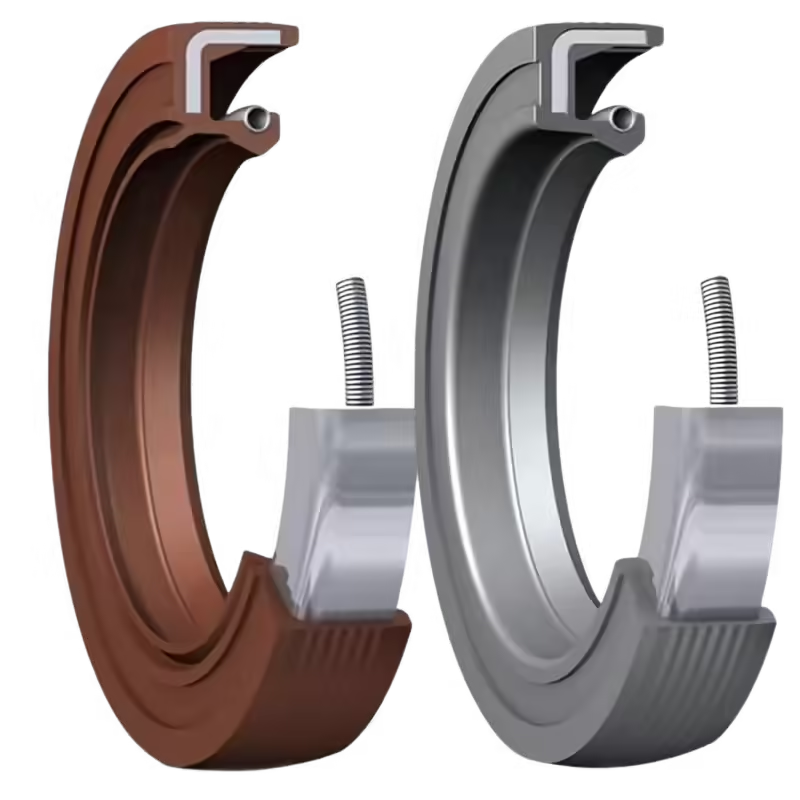How to Choose the Right Oil Seal Size: A Complete Guide
Introduction: Why Sizing Matters in Oil Seals
What Are Oil Seals?
Oil seals are crucial components in machinery and automotive systems. Their primary role is to prevent lubricating oil from leaking out, while also keeping contaminants such as dust and debris from entering mechanical parts. This ensures the smooth operation and longevity of equipment.
The Importance of Correct Sizing
Selecting the correct size for an oil seal is key to ensuring sealing effectiveness and preventing premature wear or failure. Incorrectly sized oil seals can lead to leaks, higher friction, and ultimately, costly repairs and replacements.
Understanding Oil Seal Sizes
Basic Structure of an Oil Seal
An oil seal typically consists of the following key components:
- Sealing Lip: Ensures a tight seal against the shaft to prevent leakage.
- Case: Supports the oil seal structure.
- Spring: Applies pressure to the sealing lip, ensuring long-term sealing performance.
How Oil Seal Sizes Are Noted
Oil seal sizes are expressed using three primary dimensions:
- Inner Diameter (ID): Matches the diameter of the shaft.
- Outer Diameter (OD): Corresponds to the diameter of the housing or bearing seat.
- Width (W): Indicates the thickness of the oil seal.
Metric vs. Imperial Sizes
Oil seals come in both metric (mm) and imperial (inches) sizes:
- Metric Sizes: Used globally, especially in international markets.
- Imperial Sizes: Commonly used in North American markets.
To ensure a proper fit, always confirm whether you’re using metric or imperial measurements.
How to Accurately Measure Oil Seals
Tools You’ll Need
- Calipers: To measure the inner and outer diameters.
- Micrometers: For precise measurement of the width.
- Gauge Blocks: Useful for measuring more complex shapes.
Steps to Measure Oil Seals
- Inner Diameter (ID): Use calipers to measure the inner diameter of the oil seal, ensuring it matches the shaft diameter.
- Outer Diameter (OD): Measure the outer diameter to ensure compatibility with the housing or bearing seat.
- Width (W): Use a micrometer to measure the width to confirm it aligns with the required specifications.
Tolerances
Understanding the tolerance range for oil seals is essential to ensure proper fit and function. Tolerances vary by application and material, so always consult your manufacturer’s specifications.
For a detailed guide on accurate measurement, check out our How to Measure Oil Seals.
Choosing the Right Oil Seal: A Step-by-Step Process
Step 1: Understand Your Operating Conditions
- Temperature and Pressure: Select oil seals based on the operating temperature and pressure. For high-temperature environments, FKM is ideal, while NBR is suitable for standard conditions.
- Chemical Resistance: Choose a material that is compatible with the chemicals your oil seal will encounter to prevent degradation.
Step 2: Provide Essential Information to the Manufacturer
Provide details such as:
- Fluid type
- Operational speed
- Environmental conditions
This helps manufacturers recommend the best oil seal for your specific needs.
Step 3: Material Selection
Oil seals come in several materials, each offering different performance characteristics:
- NBR (Nitrile Butadiene Rubber): Ideal for standard temperature ranges with good elasticity and oil resistance.
- FKM (Fluoroelastomer): Best for high-temperature and chemically aggressive environments.
- PTFE (Polytetrafluoroethylene): Offers excellent chemical resistance and non-stick properties.
Step 4: Size Specifications
Confirm that the oil seal size is correct by measuring the ID, OD, and width. For further details, refer to our Oil Seal Measurement Guide.
What Is the Best Oil Seal for Your Application?
The definition of the “best” oil seal depends on your specific application and operating conditions. Consider the following factors:
- Material: FKM, NBR, or PTFE, based on environmental factors like temperature and chemical exposure.
- Operating Conditions: High temperatures, pressures, and chemical exposure will dictate the ideal material.
- Cost vs. Performance: NBR is cost-effective for general use, while FKM offers superior performance for extreme conditions.
Best Oil Seals for Specific Needs
- High-Temperature Applications: FKM is the top choice for extreme heat and chemical exposure.
- Standard Applications: NBR offers a cost-effective and reliable solution for everyday use.
- Chemical Resistance: PTFE is ideal for environments where exposure to harsh chemicals is common.
Common Oil Seal Sizing Mistakes to Avoid
- Overestimating Size: Choosing a size that’s too large can result in a loose fit, leading to leakage.
- Underestimating Size: Choosing a size that’s too small can cause excessive wear and damage to the seal.
Beyond Size: Other Critical Factors
While size is essential, don’t overlook factors like material selection, temperature range, and pressure requirements for optimal oil seal performance.
Tools and Resources for Finding the Right Oil Seal Size
- Manufacturer Specifications: Always consult the manufacturer’s datasheets for the most accurate sizing information.
- Online Tools: Use online calculators to assist in selecting the right size.
- Expert Consultation: If in doubt, consult with experts to ensure you’re choosing the correct oil seal for your needs.
Custom Oil Seals for Unique Applications
Sometimes, standard oil seals won’t fit, and custom seals are required. Custom solutions are often necessary for specialized applications, but they can take longer to produce and come at a higher cost.
Common Applications and Their Oil Seal Size Requirements
- Automotive Industry: Oil seals for engines, transmissions, and axles require standard sizes.
- Industrial Machinery: Pumps, gearboxes, and hydraulic systems rely on specific oil seal sizes for smooth operation.
- Aerospace & Heavy Equipment: These high-performance sectors need precise sizing to meet demanding operational conditions.
Conclusion: Selecting the Correct Oil Seal Size
Choosing the correct oil seal size and material is critical for ensuring performance and longevity. Avoid sizing mistakes, select the appropriate material, and ensure compatibility with your operating conditions. For tailored advice and expert recommendations, feel free to reach out to us at DRO Rubber Seal.
For more information on oil seals and other sealing products, visit our website at drorubber.com.





